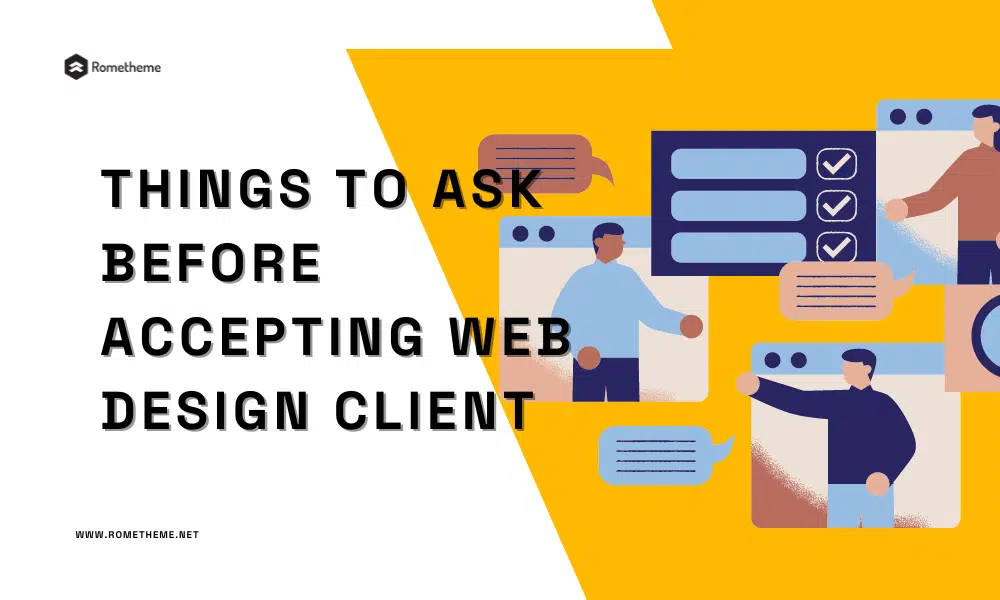Are you a web designer looking to take on new clients? Accepting a web design client without thoroughly understanding their needs and expectations can lead to a host of challenges down the line. It’s crucial to ask the right questions upfront to ensure a smooth and successful working relationship. In this article, we will explore the essential things to ask before accepting a web design client. By addressing these key points, you can save time, prevent misunderstandings, and deliver outstanding results.
Things to Ask Before Accepting Web Design Client
When embarking on a new web design project, it’s essential to gather the necessary information to understand the client’s requirements fully. Here are some crucial questions to ask before accepting a web design client:
1. What is the purpose of the website?
Understanding the purpose of the website allows you to align your design strategy with the client’s goals effectively. Is it an e-commerce site, a blog, or a portfolio? Clarifying the website’s purpose will help you create a design that meets the client’s objectives.
2. Who is the target audience?
Knowing the target audience is vital for tailoring the design and user experience. Ask the client about their target demographic, including age range, interests, and preferences. This information will guide your design decisions and ensure the website resonates with the intended audience.
3. What features and functionalities are required?
Inquire about the specific features and functionalities the client wants on their website. This may include contact forms, e-commerce capabilities, integration with third-party platforms, or content management systems. Understanding these requirements will help you determine the scope of the project and estimate the timeline accurately.
4. Do you have a budget and timeline in mind?
Discussing the client’s budget and timeline early on is essential for managing expectations. It enables you to assess whether their expectations align with the resources required to deliver the desired outcome. Understanding the budget will also help you propose appropriate design solutions within their financial constraints.
5. Have you worked with a web designer before?
Knowing whether the client has previous experience working with web designers provides valuable insights into their expectations and communication style. If they have worked with designers in the past, ask about their experiences to gain a better understanding of their preferences and potential challenges you may encounter.
6. Can you provide examples of websites you like?
Requesting examples of websites the client admires can help you gauge their design preferences and style. It gives you a starting point for understanding their aesthetic vision and allows you to create a design that aligns with their taste while incorporating your expertise.
FAQs About Accepting Web Design Clients
Here are some frequently asked questions about accepting web design clients:
1. How do I determine if a web design client is a good fit for me?
Assessing whether a client is a good fit involves considering factors such as their communication style, project requirements, and alignment with your expertise. Trust your instincts and ensure you have a clear understanding of their expectations before moving forward.
2. Should I always ask for a down payment or deposit?
Requesting a down payment or deposit is a standard practice in the web design industry. It helps protect your time and resources, as well as demonstrate the client’s commitment to the project. Clearly communicate your payment terms and expectations from the beginning.
3. What should I do if a client has unrealistic expectations?
Open and honest communication is crucial when dealing with unrealistic client expectations. Clearly explain what is feasible within the given constraints and offer alternative solutions that align with their goals. It’s essential to manage expectations early on to avoid potential conflicts or dissatisfaction later in the project.
4. How can I ensure effective communication with my web design clients?
Establishing clear lines of communication is vital for a successful web design project. Agree on the preferred communication channels, whether it’s email, phone calls, or project management tools. Set regular check-ins and provide updates to keep the client informed and involved throughout the process.
5. What happens if the project scope changes during the design process?
Scope changes are not uncommon in web design projects. It’s crucial to address scope changes promptly to avoid delays or misunderstandings. Have a clear change request process in place, including discussing the impact on the timeline and budget before proceeding with any modifications.
6. How do I handle difficult clients?
Dealing with difficult clients can be challenging, but it’s important to remain professional and maintain open lines of communication. Try to understand their concerns and find common ground to resolve any issues. If necessary, seek mediation or involve a project manager to help facilitate a constructive resolution.
Conclusion
Accepting a web design client without asking the right questions can lead to unnecessary complications and dissatisfaction for both parties. By proactively addressing key aspects such as the website’s purpose, target audience, required features, budget, and timeline, you can establish a solid foundation for a successful project. Effective communication, managing expectations, and addressing potential challenges early on are essential for a smooth client-designer collaboration. Remember, taking the time to gather comprehensive information upfront will save time, and effort, and ensure a positive outcome for both you and your client.
Visit our website to browse our stuff and follow our Instagram for great content!
Website: www.rometheme.net
Instagram: rometheme_studio









